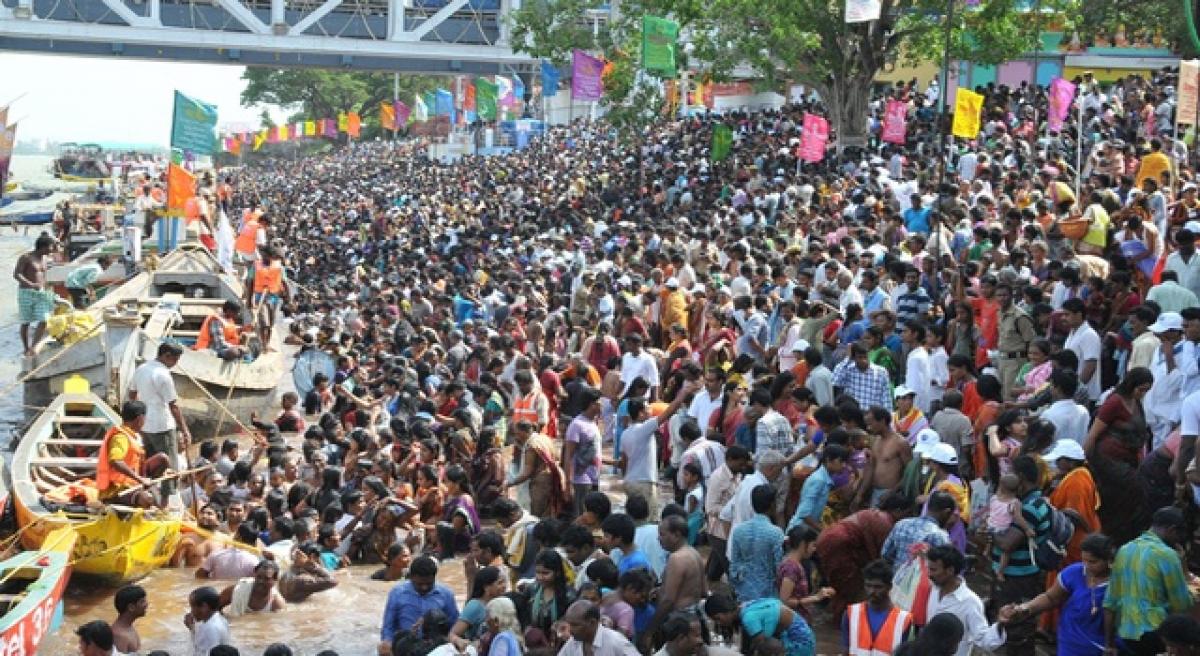Live
- Trisha celebrates 22 glorious years in showbiz
- Mohan Babu on the Run: Police Search for the Actor Across Five Locations
- Legal Precedents Cited in Allu Arjun's Court Ruling
- Renuka Swamy case: Bail granted to 7 accused including Darshan
- Bigg Boss Telugu 8 Finale: Nikhil vs Gautam Krishna - Who Will Win?
- Emotional track ‘Mari Antha Kopam’ from ‘Bachhala Malli’ unveiled
- 5 Indian scientists selected as members of EMBO Global Investigator Network
- HIV and Fertility: Making Parenthood Possible for All
- Big twist: Revathi’s husband ready to withdraw case against Allu Arjun amid legal battle
- Allu Arjun Granted Interim Bail in Stampede Case
Just In

Even as the melancholic images of Godavari Pushkara tragedy are still afresh in our minds, we prepare for Krishna Pushkaralu. The time has come to take stock of averting crowd disasters as history tells us that our official establishment often does not learn from experiences.
Even as the melancholic images of Godavari Pushkara tragedy are still afresh in our minds, we prepare for Krishna Pushkaralu. The time has come to take stock of averting crowd disasters as history tells us that our official establishment often does not learn from experiences.
Massive congregation of people is always prone to such crowd disasters. It may be due to psychological state of panic that makes the crowd go berserk. But, often such crowd behaviour turns fatal due to breakdown of co-ordination resulting out of inept planning for the event.
The history of human civilisation reveals that even the ancient man was conscious of such fatality at a time when population was so sparse. Look at the construction of Colosseum in Rome, which could take up over 70,000 visitors. It had more than 60 numbered entrances.
The exits are located side by side, around the entire circumference of the Colosseum. The Colosseum could be evacuated within just about 5 minutes. The modern man ably aided by technology can certainly plan mass events much more robust to withstand any kind of disturbances.
The crowd-carrying capacity of entry and exit points and the pathway in between should be much wider than the expected influx of people. Effective public address system should be in place to warn the public to avoid panic. The VIP movement has to be restricted, if not prevented.
Mass evacuation and mass medical emergency facilities should be in operation in an uninterrupted manner to meet any kind of exigency. According to prominent crowd safety expert, Prof G Keith Still, all areas, in which high crowd densities may occur or where many people may accumulate, must be analysed for risks.
The comprehensive crowd management plan should foresee all possible risks and clearly identify people to manage them. Spread of rumours can trigger mob frenzy for exit. Effective communication through public address system should be put in place to regulate crowds.
There are multiple causal interdependencies for a crowd-related disaster to strike. They include failure of flow controls, a lack of overview of everybody etc… (Crowd disasters as systemic failures: analysis of the Love Parade disaster by Dirk Helbing and Pratik Mukerji).
Elaborate contingency plans should be worked out and executed effectively in case earlier crowd management plans fail. Better communication should exist among all stakeholders at every stage.
The organisers should be conscious of early signs of a crowd disaster. Evacuation of people should begin before the area gets overcrowded, thus rendering it difficult to manage. This would at least mitigate the disaster, if not prevent it.
Effective crowd flow management is critical to avert such tragedies. Experts suggest measures like avoidance of intersecting flows separating different flow directions, considering alternative routes for crowds to flow, reserving space for emergency movement of personnel and vehicles, removing bottlenecks in the organisation and obstacles in the seamless flow of crowds, etc.
Crowd disasters occur due to interplay of multiple factors. There is voluminous literature to tell us how to avert such a tragedy. Lokmanya Tilak said: “The problem is not lack of resources or capability, but the lack of will.”

© 2024 Hyderabad Media House Limited/The Hans India. All rights reserved. Powered by hocalwire.com







